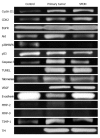Hematogenous umbilical metastasis from colon cancer treated by palliative single-incision laparoscopic surgery
- PMID: 24179626
- PMCID: PMC3812442
- DOI: 10.4240/wjgs.v5.i10.272
Hematogenous umbilical metastasis from colon cancer treated by palliative single-incision laparoscopic surgery
Abstract
Sister Mary Joseph's nodule (SMJN) is a rare umbilical nodule that develops secondary to metastatic cancer. Primary malignancies are located in the abdomen or pelvis. Patients with SMJN have a poor prognosis. An 83-year-old woman presented to our hospital with a 1-month history of a rapidly enlarging umbilical mass. Endoscopic findings revealed advanced transverse colon cancer. computer tomography and fluorodeoxyglucose-positron emission tomography revealed tumors of the transverse colon, umbilicus, right inguinal lymph nodes, and left lung. The feeding arteries and drainage veins for the SMJN were the inferior epigastric vessels. Imaging findings of the left lung tumor allowed for identification of the primary lung cancer, and a diagnosis of advanced transverse colon cancer with SMJN and primary lung cancer was made. The patient underwent local resection of the SMNJ and subsequent single-site laparoscopic surgery involving right hemicolectomy and paracolic lymph node dissection. Intra-abdominal dissemination to the mesocolon was confirmed during surgery. Histopathologically, the transverse colon cancer was confirmed to be moderately differentiated tubular adenocarcinoma. We suspect that SMJN may occur via a hematogenous pathway. Although chemotherapy for colon cancer and thoracoscopic surgery for the primary lung cancer were scheduled, the patient and her family desired home hospice. Seven months after surgery, she died of rapidly growing lung cancer.
Keywords: Hematogenous metastasis; Palliative operation; Single-incision laparoscopic surgery; Sister Mary Joseph; Umbilicus.
Figures






Similar articles
-
Sister Mary Joseph's Nodule: Where Umbilicus Holds the Truth!Cureus. 2021 Feb 3;13(2):e13091. doi: 10.7759/cureus.13091. Cureus. 2021. PMID: 33728114 Free PMC article.
-
Sister Mary Joseph's nodule: A rare metastasis of hilar cholangiocarcinoma: A new case report and review of the literature.Heliyon. 2025 Feb 3;11(4):e42449. doi: 10.1016/j.heliyon.2025.e42449. eCollection 2025 Feb 28. Heliyon. 2025. PMID: 40028571 Free PMC article.
-
Sister Mary Joseph's nodule as a presenting sign of internal malignancy.Skinmed. 2006 Sep-Oct;5(5):256-8. doi: 10.1111/j.1540-9740.2006.04826.x. Skinmed. 2006. PMID: 16957443
-
Carcinoma of the right side colon accompanied by Sister Mary Joseph's nodule and inguinal nodal metastases: a case report and literature review.Chin J Cancer. 2010 Feb;29(2):239-41. doi: 10.5732/cjc.009.10106. Chin J Cancer. 2010. PMID: 20109359 Review.
-
Primary clear cell adenocarcinoma of the peritoneum presents as Sister Mary Joseph's nodule: a case report and literature review.Eur J Gynaecol Oncol. 2014;35(6):745-8. Eur J Gynaecol Oncol. 2014. PMID: 25556287 Review.
Cited by
-
Cutaneous Metastasis after Surgery, Injury, Lymphadenopathy, and Peritonitis: Possible Mechanisms.Int J Mol Sci. 2019 Jul 4;20(13):3286. doi: 10.3390/ijms20133286. Int J Mol Sci. 2019. PMID: 31277406 Free PMC article. Review.
-
Laparoscopic Distal Pancreatectomy with or without Preservation of the Spleen for Solid Pseudopapillary Neoplasm.Case Rep Surg. 2015;2015:487639. doi: 10.1155/2015/487639. Epub 2015 Oct 26. Case Rep Surg. 2015. PMID: 26587305 Free PMC article.
-
A long-term survival case of Sister Mary Joseph's nodule caused by colon cancer and treated with a multidisciplinary approach.Nagoya J Med Sci. 2019 May;81(2):325-329. doi: 10.18999/nagjms.81.2.325. Nagoya J Med Sci. 2019. PMID: 31239600 Free PMC article.
-
Protocol for laparoscopic cholecystectomy: Is it rocket science?World J Gastroenterol. 2016 Dec 21;22(47):10287-10303. doi: 10.3748/wjg.v22.i47.10287. World J Gastroenterol. 2016. PMID: 28058010 Free PMC article. Review.
-
Sister Mary Joseph nodule in colorectal cancer.Ulus Cerrahi Derg. 2014 Dec 25;32(4):295-297. doi: 10.5152/UCD.2014.2686. eCollection 2016. Ulus Cerrahi Derg. 2014. PMID: 28149131 Free PMC article.
References
-
- Powell JL. Powell’s pearls: eponyms in medical and surgical history. Sister Joseph’s Nodule; Sister Mary Joseph (1856-1939) J Surg Educ. 2011;68:442–443. - PubMed
-
- Mayo W. Metastasis in cancer. Proc Staff Meet Mayo Clin. 1928;3:327.
-
- Balsarkar DJ, Jakhere S. Sister Mary Joseph nodule. Indian J Gastroenterol. 2012;31:38. - PubMed
-
- Abu-Hilal M, Newman JS. Sister Mary Joseph and her nodule: historical and clinical perspective. Am J Med Sci. 2009;337:271–273. - PubMed
-
- Kundranda MN, Daw AH. Sister Mary Joseph nodule: an important sign of an ominous diagnosis. Intern Med J. 2006;36:617. - PubMed
LinkOut - more resources
Full Text Sources
Other Literature Sources

